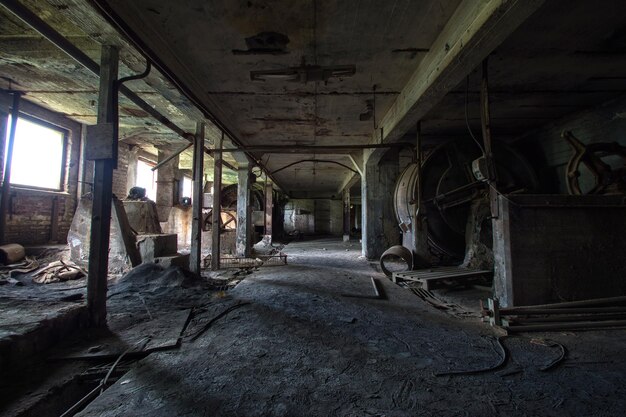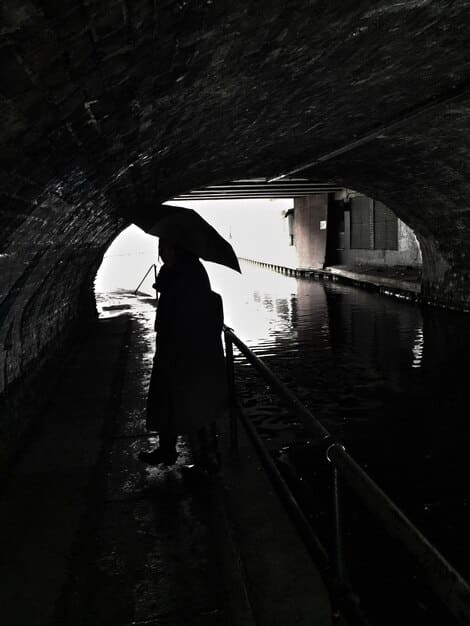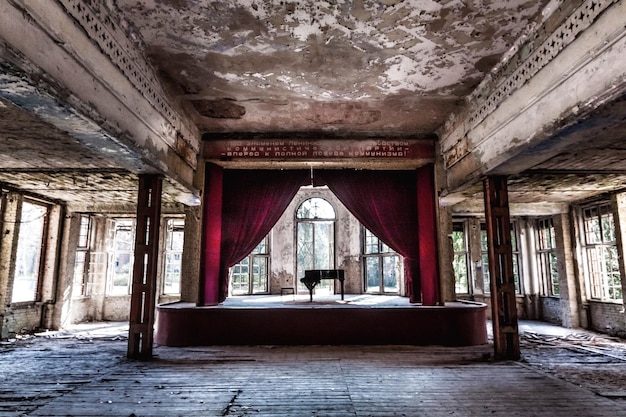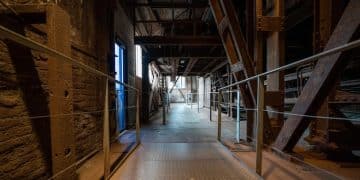Urban Exploration in the US: Unveiling Risks, Rewards & Hidden Spaces

Urban exploration in the US involves venturing into abandoned or restricted urban spaces, offering unique experiences but also posing risks such as physical dangers, legal repercussions, and ethical considerations.
Urban exploration, or “urbex,” in the US is more than just trespassing; it’s a venture into forgotten corners of society, where abandoned buildings and hidden infrastructure whisper stories of the past. It’s a pursuit that balances the thrill of discovery with inherent risks and ethical responsibilities.
What is Urban Exploration?
Urban exploration is the act of exploring man-made structures, usually abandoned or off-limits to the general public. These can include abandoned buildings, tunnels, sewers, and other hidden or forgotten places within urban environments. It’s a hobby that combines elements of adventure, photography, history, and a bit of rule-breaking.
Why do people engage in this activity? The allure of the unknown is a powerful draw. For some, it’s about documenting places before they are lost to demolition or redevelopment. For others, it’s the thrill of seeing something few others have witnessed.
The Urbex Philosophy
At its core, urban exploration is guided by a few key principles, often self-imposed:
- “Take only photos, leave only footprints.”
- Avoid vandalism or theft.
- Respect the history and integrity of the site.
While these guidelines are generally followed, they are not universal, and the ethical considerations of urbex are frequently debated within the community.

Risks Involved in Urban Exploration in the US
Urban exploration is not without its dangers. Abandoned sites are often in disrepair and can present a variety of hazards. It’s crucial to understand and prepare for these risks before venturing into such environments.
These risks range from physical dangers to legal issues.
Physical Dangers
The most immediate risks are physical:
- Structural collapse: Floors, ceilings, and walls can be unstable and prone to collapse.
- Hazardous materials: Asbestos, mold, and other toxic substances are common in older buildings.
- Sharp objects: Broken glass, rusty metal, and other debris can cause cuts and infections.
- Falls: Open shafts, missing staircases, and uneven surfaces can lead to serious injuries.
Legal Ramifications
Trespassing is a crime in most jurisdictions, and urban explorers can face arrest and prosecution.
- Civil Trespass: Entering private property without permission opens individuals up to potential liability for damages and legal action from property owners.
- Criminal Trespass: Depending on the jurisdiction and posted signage, entering certain areas can lead to formal arrest and prosecution.
In some cases, exploring certain types of infrastructure, like subway tunnels or power plants, can carry even more severe penalties due to security concerns.
To mitigate these risks, experienced urban explorers often conduct thorough research before entering a site, carry safety equipment like flashlights and respirators, and explore in groups to provide support and assistance.
The Allure of Abandoned Spaces
Despite the risks, urban exploration remains a popular activity. The allure of abandoned spaces lies in their unique blend of history, mystery, and decay. These places offer a glimpse into the past, allowing explorers to imagine what life was like when they were still in use.
The beauty of decay, often referred to as “ruin porn,” is a significant draw for many urbex enthusiasts. The crumbling facades, overgrown vegetation, and faded paint can be strangely beautiful and evocative.

Photography and Documentation
Many urban explorers are also photographers, documenting their findings with stunning images.
- Capturing Decay: The photographic aspect of urbex allows explorers to document and share the beauty and decay of abandoned spaces.
- Preserving History: Photography helps preserve a visual record of places that might otherwise be forgotten or demolished.
These images often serve as a form of preservation, capturing a moment in time before the building is lost forever.
The sense of discovery is another key motivator. Exploring a hidden tunnel or climbing to the top of an abandoned skyscraper can provide a unique adrenaline rush and a feeling of accomplishment.
Urban Exploration and the Law
Navigating the legal landscape is a critical aspect of urban exploration. Trespassing laws vary by state and locality, and the consequences can range from a warning to arrest and prosecution.
Understanding the difference between civil and criminal trespass is essential. Civil trespass involves entering private property without permission, while criminal trespass typically requires the presence of “no trespassing” signs or verbal warnings.
Minimizing Legal Risks
While no amount of preparation can guarantee complete immunity from legal repercussions, doing the following steps can minimize risks:
- Researching local laws: Prior to exploration, research the state’s trespassing laws and local ordinances.
- Avoiding Forced Entry: Never breaking locks, damaging property, or forcing your way into a building, as this can lead to additional charges.
- Obtaining Permission: When possible, seeking permission from the property owner before entering a site.
It is essential to know your rights and responsibilities if confronted by law enforcement. Remaining polite and respectful, and refraining from providing unnecessary information, are the first steps to take. Knowing when to hire a lawyer can be useful, too.
Ethical Considerations of Urbex
Beyond the legal aspects, urban exploration raises several ethical considerations. The primary issue is respecting the integrity of the site and avoiding any actions that could damage or alter it.
Vandalism, graffiti, and theft are strictly condemned within the ethical urbex community. The goal is to observe and document, not to exploit or destroy.
Respecting the Space
Ethical urban exploration is rooted in respect for the spaces encountered.
- Avoiding Vandalism: Never defacing walls or damaging property.
- Not Taking Souvenirs: Resisting the temptation to take items from the site.
- Leaving No Trace: Pack out all trash and avoid disturbing the environment.
Another ethical concern is the impact of online sharing. Posting location details on public forums can attract unwanted attention, leading to vandalism, theft, and increased security measures.
Some explorers prefer to keep locations secret, sharing information only with trusted members of the community. This helps protect the sites and preserve them for future exploration.
Notable US Locations for Urban Exploration
The United States offers a wealth of potential locations for urban exploration, from abandoned factories in the Rust Belt to forgotten military installations in the Southwest.
Some popular destinations include:
Eastern State Penitentiary, Philadelphia
This former prison is a historic landmark with a dark and haunting atmosphere. Its crumbling cellblocks and imposing architecture make it a popular destination for urbex photographers.
North Brother Island, New York City
This island in the East River was once home to a hospital and quarantine facility. Today, it is overgrown with vegetation and populated by abandoned buildings, offering a glimpse into the city’s past.
Gary, Indiana
This former steel town is filled with abandoned factories, theaters, and homes, offering a stark reminder of the decline of American industry. However, it also poses significant safety risks due to structural instability and crime.
Safety Gear and Essential Equipment
Proper clothing and equipment can significantly mitigate the risks associated with urban exploration. It’s essential to dress appropriately and carry the necessary tools to navigate potentially hazardous environments.
Essential gear includes:
- Sturdy Boots: Protecting your feet from sharp objects and uneven surfaces.
- Headlamp or Flashlight: Providing illumination in dark and confined spaces.
- Respirator: Filtering out dust, mold, and other airborne contaminants.
Additional Safety Tips
Safety is the highest priority for urban explorers:
- Exploring with a Buddy: Never explore alone, and always inform someone of your destination and expected return time.
- Checking the Weather: Be aware of weather conditions, as rain or snow can make surfaces slippery and increase the risk of falls.
- Respecting Boundaries: If a site feels unsafe or too dangerous, turn back.
By taking these precautions, urban explorers can minimize the risks and enjoy the unique experiences that abandoned spaces have to offer.
| Key Element | Brief Description |
|---|---|
| ⚠️ Risks | Physical dangers and legal issues like trespassing. |
| 📸 Photography | Capturing decay and documenting history. |
| ⚖️ Legal Aspects | Understanding and minimizing legal risks due to trespassing. |
| 🔦 Equipment | Sturdy shoes, flashlight, and respirator are essential. |
FAQ
▼
Yes, urban exploration often involves trespassing, which is illegal. Penalties vary depending on the location but can include fines, arrest, and prosecution. Always research local laws.
▼
Risks include structural collapse, hazardous materials, sharp objects, falls, and legal consequences. It is important to prepare well and to minimize these risks.
▼
Finding locations often involves research, word-of-mouth, and online communities. However, be respectful of the space and laws. Do not publicize locations.
▼
Ethical urbex involves “take only photos, leave only footprints.” Avoid vandalism, theft, and disturbing the environment. Respect locations.
▼
Bring sturdy boots, a headlamp or flashlight, a respirator, and a first-aid kit. Also, go with a buddy. Inform someone of your plans.
Conclusion
Urban exploration in the US offers a unique blend of adventure, history, and photography. However, it’s an activity that demands respect for the law, a commitment to ethical practices, and a thorough understanding of the potential dangers involved. By prioritizing safety and adhering to a strict code of conduct, explorers can uncover the hidden stories of abandoned spaces while minimizing the risks.





